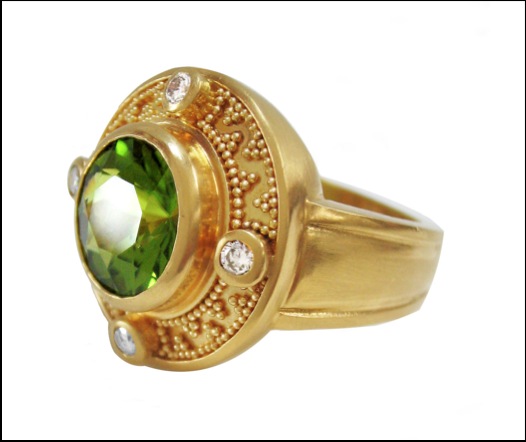Check out our Peridot board on Pinterest for more photos and info!

Ring in 22 karat gold by Julie Rauschenberger, featuring a peridot center stone.
Peridot
The fresh lime green of peridot is its distinctive signature. Its spring green color also is ideal with sky blue. Peridot is treasured in Hawaii as the goddess Pele's tears. The island of Oahu even has beaches made out of tiny grains of peridot. Although Hawaii’s volcanoes have produced some peridot large enough to be cut into gemstones, virtually all peridot sold in Hawaii today is from Arizona, another state with extreme geology.
Today most peridot is mined, often by hand, by Native Americans on the San Carlos Reservation in Arizona. Peridot found here is beautiful in color but relatively small in size. Faceted peridot from Arizona is rare in sizes above five carats. Fine large peridot are found in Burma and large quantities of peridot are also mined in China. In 1994, an exciting new deposit of fine peridot was discovered in Pakistan, 15,000 feet above sea level in the far west of the Himalaya Mountains in the Pakistanian part of Kashmir.
Peridot, the birthstone for August, is harder than metal but softer than many gemstones. Store peridot jewelry with care to avoid scratches and protect from blows. Because peridot is sensitive to rapid changes in temperature, never have it steam cleaned and avoid ultrasonics. Clean with mild dish soap: use a toothbrush to scrub behind the stone where dust can collect. Your AGTA jeweler will tell you how to best care for your peridot.
----------
In addition to
the above information from the AGTA and other sources, you
can find facts about these of gems and more at the
"Gems
and Gem Materials"
online course,
through the University of California-Berkeley's Department
of Earth and Planetary Science. The website is available
for the general public, and contains a wealth of
information for the budding gemologist and anyone
interested in learning more about gemstones. Hanna
Cook-Wallace has contributed to this site, which was
developed by Jill Banfield while teaching at the University
of Wisconsin.